Explore 22 real-world examples of AI in hospitals—from chatbots and no-show prediction to imaging and billing—that boost efficiency and patient care outcomes.

Artificial intelligence is no longer a futuristic concept in medicine, it’s a present day reality. AI healthcare companies are rapidly changing how providers deliver care and how patients manage their health. From automating tedious administrative tasks to uncovering new life saving treatments, these innovators are tackling some of the biggest challenges in the industry. They leverage technologies like machine learning and natural language processing to streamline operations, improve clinical outcomes, and create a more efficient and accessible healthcare system for everyone.
The AI in healthcare market is experiencing explosive growth. The U.S. market alone was estimated at over $8.4 billion in 2024 and is projected to skyrocket to nearly $195 billion by 2034, growing at an astonishing rate. This surge is driven by the urgent need to solve persistent problems like staff burnout, rising administrative costs, and bottlenecks in patient access. Healthcare has become a leader in AI adoption, deploying domain specific tools at more than twice the rate of the broader economy. This rapid adoption signals a fundamental shift, as providers and payers alike recognize that AI is essential for survival and growth.
AI is making a tangible impact at every step of the patient experience. Leading AI healthcare companies are focused on solving specific, high friction problems that bog down the system.
For many patients, the healthcare journey begins with a phone call. Unfortunately, this first step is often plagued by long hold times and complex phone menus, leading to frustration and abandoned calls. This is a critical area where AI shines. Platforms like Prosper AI deploy voice AI agents that can answer patient calls instantly, 24/7, to schedule appointments, handle intake, and answer common questions without forcing patients to wait on hold. See how Prosper AI works. This not only improves the patient experience but also helps reduce no show rates, which can range from 5% to over 30% depending on the specialty.
Administrative tasks consume an enormous amount of time and money in healthcare. In fact, physicians can spend nearly 14 hours per week just on prior authorization tasks. This administrative burden is a major driver of physician burnout, which still affects over 45% of doctors. AI healthcare companies are automating these repetitive workflows with incredible results. AI agents can:
Verify patient benefits and eligibility: Making outbound calls to payers to get detailed benefits information in hours, not days.
Automate prior authorizations: Handling the entire process from initiation to follow up, reducing care delays. More than 9 in 10 physicians report that prior authorizations delay necessary care.
Check claim status: Continuously following up with payers on unpaid claims to accelerate collections and reduce denials.
By offloading these phone heavy tasks, AI allows staff to focus on more complex, patient facing work, a major unlock for medical billing companies that need to automate payer calls at scale.
Beyond administrative tasks, AI is also transforming clinical work. Machine learning models can analyze medical images with remarkable accuracy, sometimes detecting diseases like cancer earlier than the human eye. In pharmaceuticals, AI is accelerating drug discovery by years, analyzing vast datasets to identify promising new treatment targets. While not the focus of patient access platforms like Prosper AI, these advancements are a crucial part of the AI healthcare landscape.
Trust is the bedrock of healthcare, and for AI to succeed, it must be safe, reliable, and secure. AI healthcare companies operating in the U.S. must adhere to strict HIPAA regulations to protect patient information. Leading platforms go further, achieving certifications like SOC 2 Type II to validate their security controls. When choosing a partner, it’s critical to ask about their compliance posture, data encryption policies, and how they ensure the accuracy of their AI models. For instance, some platforms offer AI powered quality assurance on every interaction to maintain accuracy rates of 99% or higher.
This list was compiled based on several key factors:
Innovation: Companies developing novel solutions to significant healthcare problems.
Impact: Demonstrable results and real world evidence of improving efficiency, cost, or patient outcomes.
Market Traction: Strong customer adoption, partnerships, and industry recognition.
Specialization: A deep focus on solving specific healthcare challenges, rather than offering a generic AI tool.
The healthcare industry is undergoing a significant transformation driven by artificial intelligence. These top 20 AI healthcare companies are at the forefront of this revolution, developing innovative solutions that enhance diagnostics, streamline workflows, and personalize patient care. From ambient AI that reduces administrative burdens to advanced algorithms that analyze medical images with superhuman precision, these companies are reshaping the future of medicine.
This first group of companies is focused on the critical area of patient access and AI scribes. These solutions are designed to alleviate the administrative burden on clinicians by automating calls, documentation, and other time-consuming tasks. By seamlessly integrating into the clinical environment, these tools allow healthcare professionals to focus more on patient interaction and care, ultimately improving both the provider and patient experience. This is especially valuable for specialty group practices.

Prosper AI brings always-on, HIPAA‑compliant voice agents to the front lines of patient access and revenue cycle, so phones get answered instantly and routine calls resolve themselves. Its LLM-driven conversations follow prebuilt Blueprints and pass a rigorous QA layer to handle complex payer and scheduling logic.
What it powers: High‑volume scheduling, benefits/eligibility checks, prior auth status and initiation, claims and denials follow‑up, managed end to end by specialized agents.
Products and integrations: Out‑of‑the‑box Blueprints plus 80+ native integrations with major EHRs/PMs (Epic, athenahealth, eClinicalWorks, NextGen) for rapid enterprise rollouts.
Impact and validation: 60%+ appointment scheduling automation, zero wait times, and ~50% call‑cost reduction; adopted by a Providence‑affiliated hospital, a Fortune 50 pharma hub, and leading billing companies.
Fit and deployment: Best for health systems, specialty groups, and RCM firms; HIPAA/SOC 2 with cloud or on‑prem options.

DeepScribe’s ambient AI listens in the exam room and writes like a seasoned clinician, translating conversations into structured notes while surfacing coding and quality cues in real time.
What it powers: End‑to‑end clinical documentation with on‑the‑fly ICD‑10, HCC, and E/M suggestions.
Products and integrations: HealAI‑powered platform with deep Epic integrations (SmartData) and premier support for Flatiron’s OncoEMR, plus athenahealth.
Impact and validation: 98.8 KLAS score; enterprise‑wide deployment at Ochsner; nearly 1,000 oncologists use it daily; documentation time down ~75%.
Fit and deployment: Ideal for health systems and specialty groups; HIPAA‑compliant, SOC 2, cloud‑native on AWS.

Suki pairs best‑in‑class speech with medically tuned LLMs to lift the paperwork weight from clinicians, generating ambient notes, answering quick clinical questions, and streamlining coding.
What it powers: Ambient documentation, voice commands, coding support, and pre‑charting via Suki Assistant.
Products and integrations: Deep, bidirectional EHR integrations (Epic, Oracle Health, athenahealth, MEDITECH) to keep data in sync.
Impact and validation: AAFP study showed a 72% median reduction in documentation time; OrthoAtlanta saw a 19% drop in denials and 12% encounter lift.
Fit and deployment: Built for health systems and large specialties; HIPAA/SOC 2; cloud delivery.
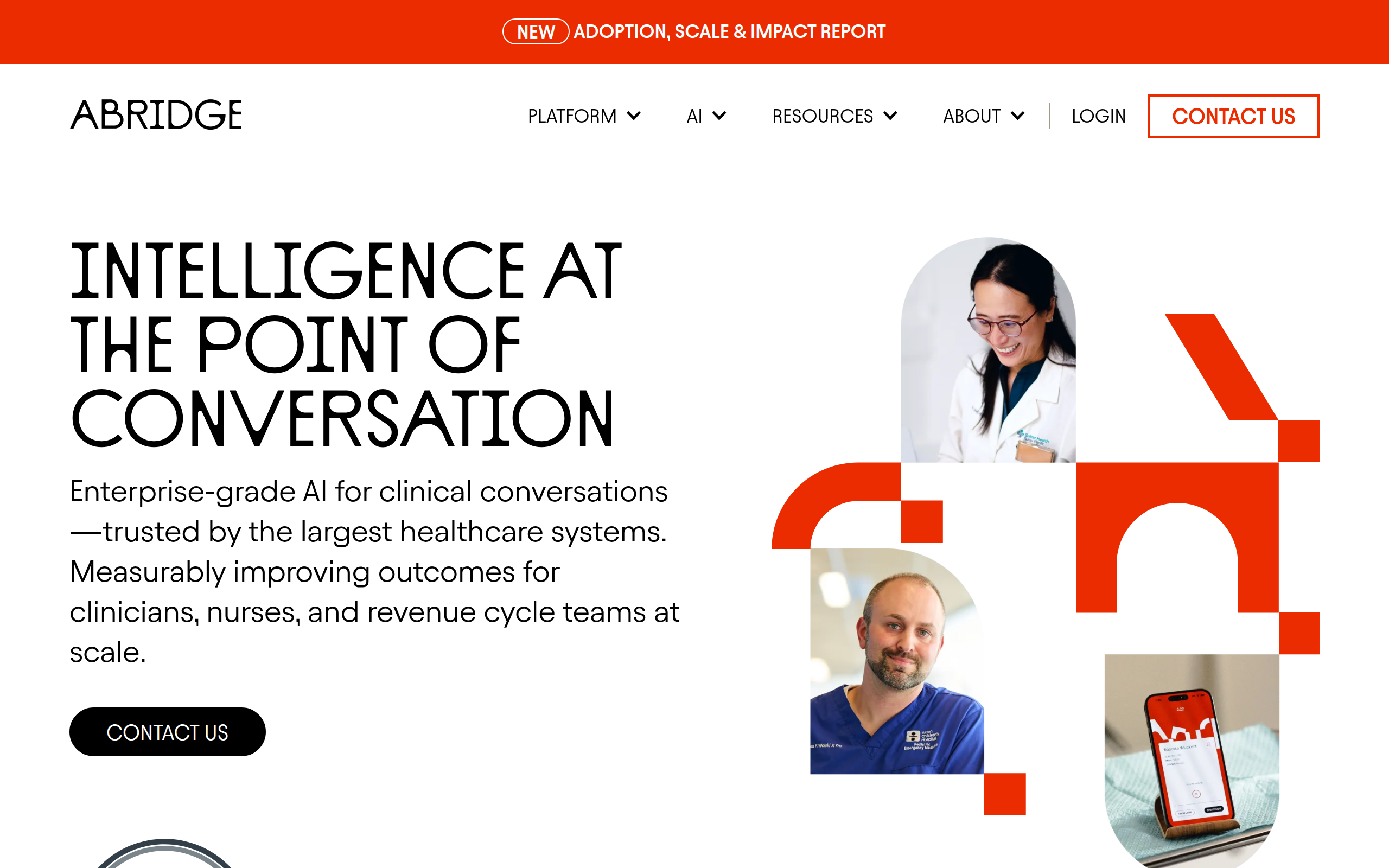
Abridge turns the visit into a structured chart in seconds, using speech recognition and LLMs, plus a Contextual Reasoning Engine that pulls EHR context, to draft notes, line up codes, and even suggest orders.
What it powers: Point‑of‑care note creation, order suggestions, and real‑time prior auth support across care settings.
Products and integrations: Abridge Inside embeds natively in the EHR; deep Epic “Pal” integration and athenahealth Ambient Notes.
Impact and validation: Used by 200+ health systems (e.g., Northwell, UPMC); Best in KLAS 2025 for Ambient Speech; JAMA Network Open study shows reduced documentation time and burnout.
Fit and deployment: For health systems and large practices; cloud‑based, HIPAA‑compliant, SOC 2.
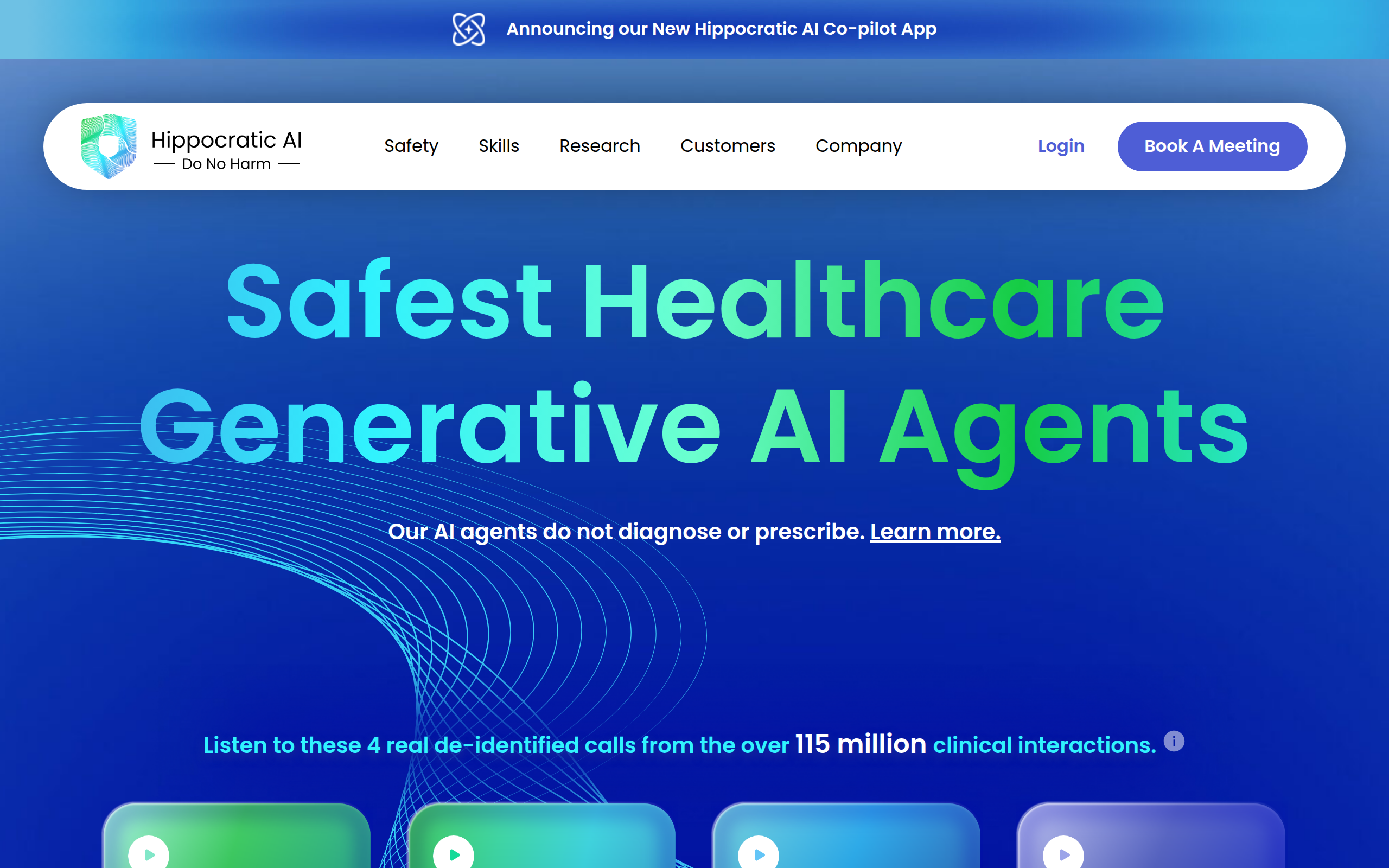
Hippocratic AI designs voice‑first agents for high‑touch, non‑diagnostic tasks like outreach, education, and care navigation, engineered with a safety‑first LLM constellation, supervisory models, and live nurse escalation.
What it powers: Scheduling, post‑discharge outreach, chronic care nudges, wellness intake, and patient education at scale.
Products and integrations: Polaris LLM; Co‑Pilot app for nurses; Epic and Oracle Health connectivity via FHIR/HL7.
Impact and validation: Deployed by WellSpan and UHS; reported 30% readmission reductions and higher engagement; stress‑tested with 500,000+ calls by 7,000+ clinicians with no severe‑harm errors.
Fit and deployment: Ideal for health systems and payors; HIPAA‑aligned, SOC 2/HITRUST, cloud‑based.
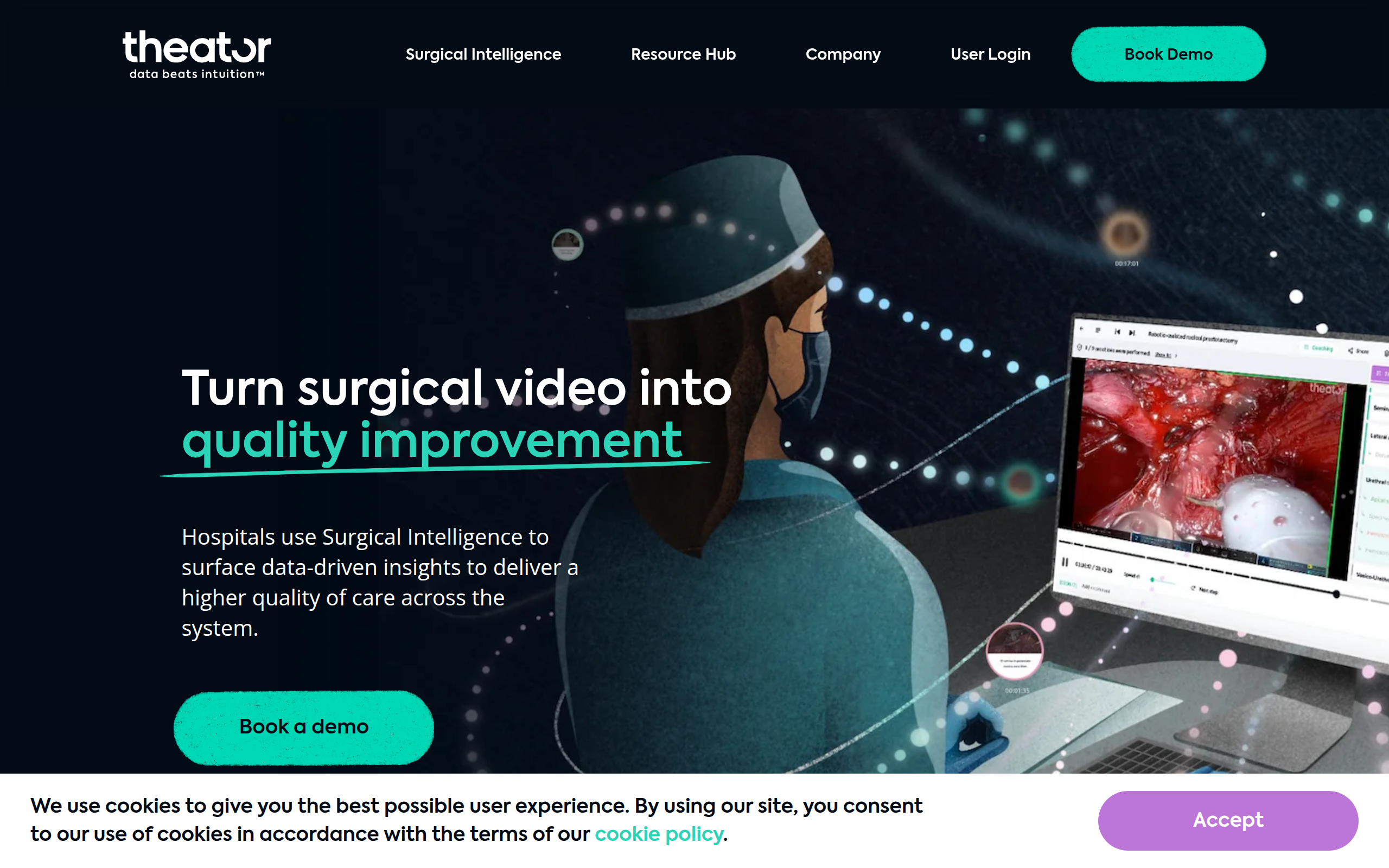
Theator turns OR video into surgical intelligence, segmenting procedures into key steps and safety milestones to elevate training, quality, and throughput, and then auto‑drafting operative reports grounded in what actually happened.
What it powers: Quality improvement, GME, and documentation, including video‑verified operative report generation for coding accuracy.
Products and integrations: Platform integrates with Epic, Cerner, and Meditech to link surgical video with outcomes and documentation.
Impact and validation: Up to 25% reductions in operative time and 56% increases in safety milestones; $162k reimbursement recovery at a single hospital; partners include Mayo Clinic and McGill.
Fit and deployment: Best for health systems and academic centers; HIPAA, SOC 2, HITRUST‑certified cloud SaaS.
The companies in this section are revolutionizing medical imaging and radiology through the power of artificial intelligence. Their technologies assist radiologists in a variety of ways, from triaging urgent cases and improving diagnostic accuracy to optimizing workflow efficiency. By analyzing medical images with incredible speed and precision, these AI platforms are helping to identify critical findings that might otherwise be missed, leading to faster and more effective treatment decisions.
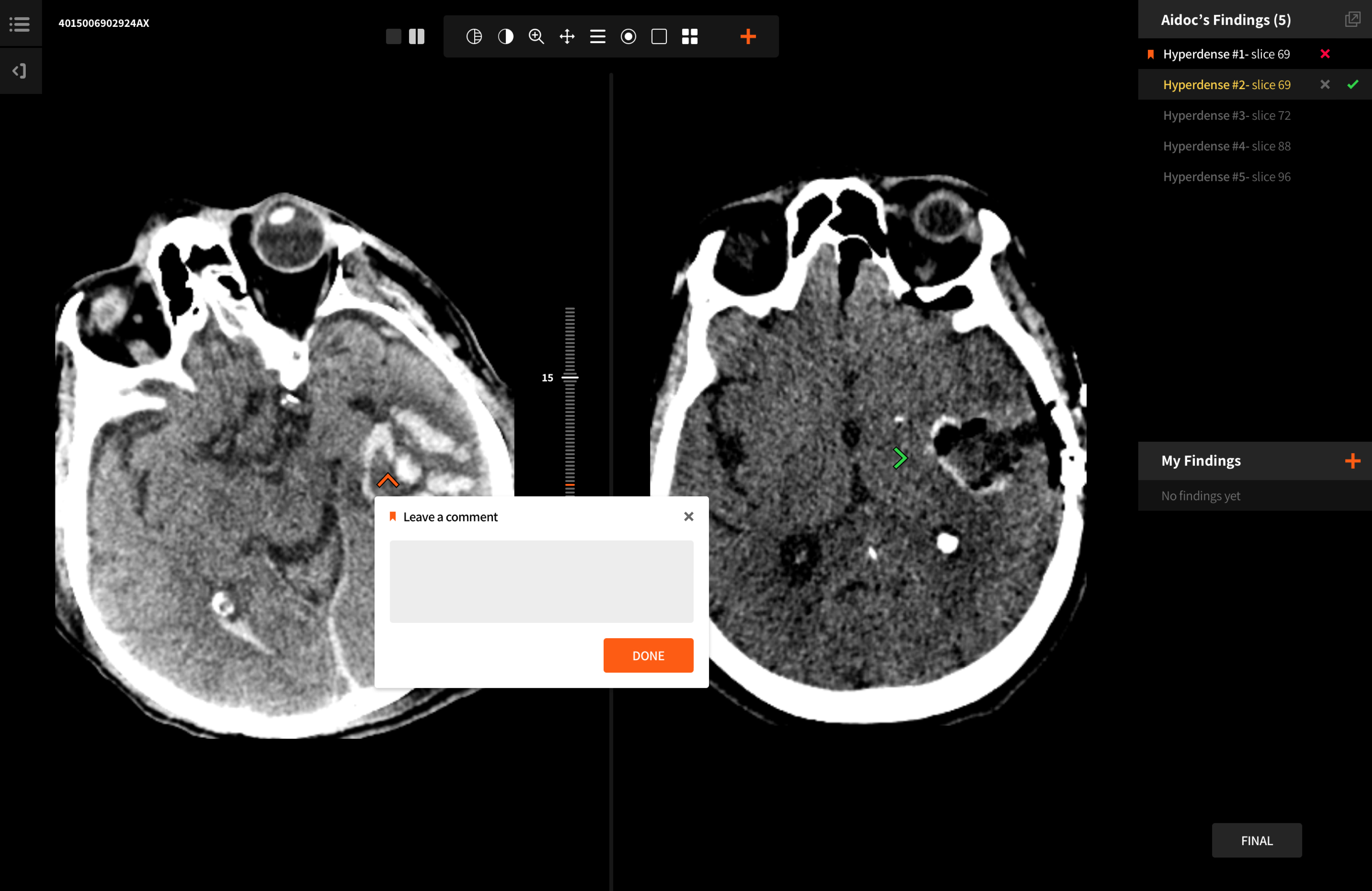
Aidoc analyzes medical images at enterprise scale, triaging acute conditions and orchestrating care with a foundation model‑powered platform that meets radiologists where they work, inside PACS, reporting tools, and the EHR.
What it powers: Acute triage and care coordination for stroke, PE, aneurysm, and more via a unified aiOS.
Products and integrations: aiOS, native Epic app, vendor‑agnostic PACS/VNA connectivity, Nuance PowerScribe, hosted on AWS/Azure for flexible deployment.
Impact and validation: Live in 1,600+ hospitals with 18 FDA clearances (including a foundation‑model tool); reduces turnaround times and length‑of‑stay; partners like Advocate Health report meaningful downstream revenue gains.
Fit and deployment: Ideal for health systems and large radiology groups; HIPAA/SOC 2, cloud‑based.

RapidAI speeds neurovascular care by applying computer vision and predictive AI to CT and MRI, helping teams triage, diagnose, and activate pathways for stroke, ICH, and aneurysm when minutes matter most.
What it powers: Imaging analysis for Rapid NCCT Stroke, Rapid LVO, Rapid Aneurysm; unified worklists, reporting, and collaboration.
Products and integrations: Rapid Enterprise Platform connects to PACS, RIS, and EMR via DICOM and HL7/FHIR for seamless workflow fit.
Impact and validation: Used at 2,200+ hospitals worldwide; multiple FDA clearances; demonstrated door‑to‑treatment time reductions up to 37 minutes.
Fit and deployment: Built for health systems and stroke networks; cloud or on‑prem with HIPAA/GDPR alignment.
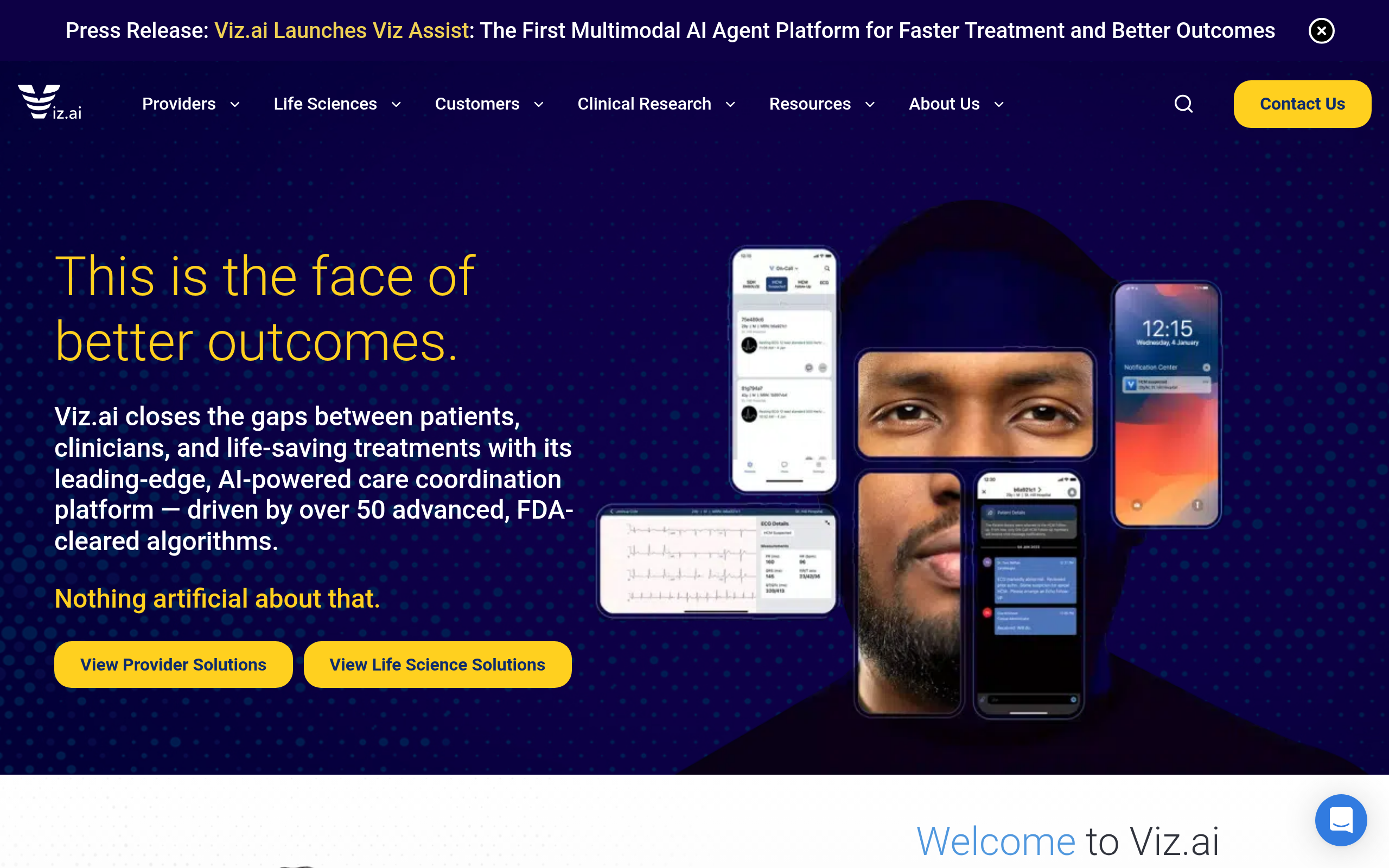
Viz.ai connects imaging intelligence with care team activation, using deep learning to flag time‑sensitive findings and generative co‑pilots to summarize EHR context so treatment moves as fast as clinical judgment.
What it powers: Imaging triage and multidisciplinary activation across Neuro, Vascular, Cardiology, and Radiology suites.
Products and integrations: PACS via DICOM; bi‑directional EHR exchange (e.g., Epic via FHIR); runs on Microsoft Cloud for Healthcare.
Impact and validation: In 1,700+ hospitals, impacting a patient every 12 seconds; real‑world data shows a 39.5‑minute reduction to neurointerventionalist contact; multiple FDA De Novo clearances.
Fit and deployment: Best for health systems and cardiovascular service lines; HIPAA‑compliant, SOC 2, cloud SaaS.

Qure.ai applies deep‑learning vision models to chest X‑rays and CTs, triaging critical findings, auto‑structuring reports, and coordinating follow‑ups for emergency, ICU, and oncology workflows at scale.
What it powers: FDA‑cleared qER for head CT triage and qXR for chest X‑ray analysis, plus qTrack for care coordination.
Products and integrations: Distributed via Nuance Precision Imaging Network, GE HealthCare, Blackford, and Sectra marketplaces for easy enterprise adoption.
Impact and validation: Deployed at 4,800+ sites; 19 FDA clearances; validated by MGH and leveraged by vRad to prioritize thousands of studies monthly.
Fit and deployment: Ideal for health systems and teleradiology; HIPAA compliant; cloud or on‑prem deployments.

Subtle Medical accelerates MRI and PET without cutting corners, using FDA‑cleared deep‑learning to denoise and enhance images, either at the scanner or during post‑processing.
What it powers: Faster MRI and PET acquisition, higher image quality, and improved throughput across busy departments.
Products and integrations: SubtleMR, SubtlePET, SubtleHD; standards‑based DICOM integration or direct embeds with OEMs like Siemens Healthineers’ Open Recon.
Impact and validation: 600+ U.S. installs at leaders like RadNet and SimonMed; up to 80% faster scans; multiple FDA/CE approvals and peer‑reviewed evidence.
Fit and deployment: For imaging centers and health systems; HIPAA compliant, SOC 2, cloud or on‑prem appliance.

Rad AI personalizes radiology reporting with generative models trained on vast report corpora, drafting impressions and narratives in each radiologist’s style while closing the loop on follow‑up care.
What it powers: Automated reporting and impression generation plus follow‑up coordination to raise care completion rates.
Products and integrations: Reporting, Impressions, and Continuity modules integrate with existing PACS/RIS/EHR; distributed via partners like Siemens Healthineers.
Impact and validation: Trusted by 50%+ of U.S. health systems; saves 60+ minutes per shift; Continuity lifts critical follow‑up completion from <30% to >75%.
Fit and deployment: Built for health systems and large radiology groups; HIPAA‑aligned, SOC 2, cloud.

Sirona reimagines radiology IT as a cloud OS, unifying worklist, viewer, reporting, and AI orchestration, while layering in computer vision and a radiology‑specific LLM to accelerate reads and impressions.
What it powers: End‑to‑end diagnostic reading, reporting, and algorithm orchestration with Pixel Powered Reporter.
Products and integrations: Cloud‑native overlay to existing PACS/RIS/EHR via HL7 and DICOM; incorporates FDA‑cleared Nines algorithms.
Impact and validation: Adopted by numerous practices including a top U.S. group for business continuity; proven AI triage and measurement capabilities via Nines acquisition.
Fit and deployment: Ideal for radiology groups and health systems; HIPAA‑compliant, SOC 2, FDA‑regulated.

Cleerly quantifies coronary plaque from CT using deep‑learning vision, turning images into interactive, decision‑ready reports that personalize care for coronary artery disease.
What it powers: Plaque characterization and ischemia risk prediction to guide diagnosis and therapy selection.
Products and integrations: Cleerly LABS and ISCHEMIA; DICOM ingestion from PACS via on‑prem appliance; Epic and PowerScribe hooks; integration with Viz.ai.
Impact and validation: FDA‑cleared and clinically validated (CERTAIN trial); changed management in 57%+ of patients; Medicare and commercial coverage in place.
Fit and deployment: For health systems and cardiology groups; HIPAA‑compliant, SOC 2‑supported SaaS.
Beyond general radiology, a growing number of AI companies are developing highly specialized diagnostic tools for specific medical fields. This section highlights innovators in pathology, ophthalmology, and oncology who are creating AI-powered solutions to detect and diagnose diseases with greater accuracy and efficiency. These specialized applications are poised to make a significant impact on early disease detection and personalized medicine.

PathAI turns digital slides into quantitative evidence, applying computer vision and deep learning to detect and score biomarkers that guide oncology diagnosis, clinical trials, and companion diagnostic development, all inside a modern pathology workflow.
What it powers: Primary diagnosis and biomarker quantification across oncology use cases within a unified pathology platform.
Products and integrations: AISight Dx for case management and viewing; AISight Link for bi‑directional LIS/EHR connectivity (e.g., Epic Beaker); interoperable with major scanners (Roche, Leica).
Impact and validation: AISight Dx holds FDA 510(k) clearance and CE‑IVDR marking; customers include Quest Diagnostics, Hoag Health, and Rede D’Or; companion diagnostic collaboration with Roche.
Fit and deployment: Built for health systems and biopharma; FDA‑cleared, CE‑marked, ISO‑certified, cloud‑deployed.
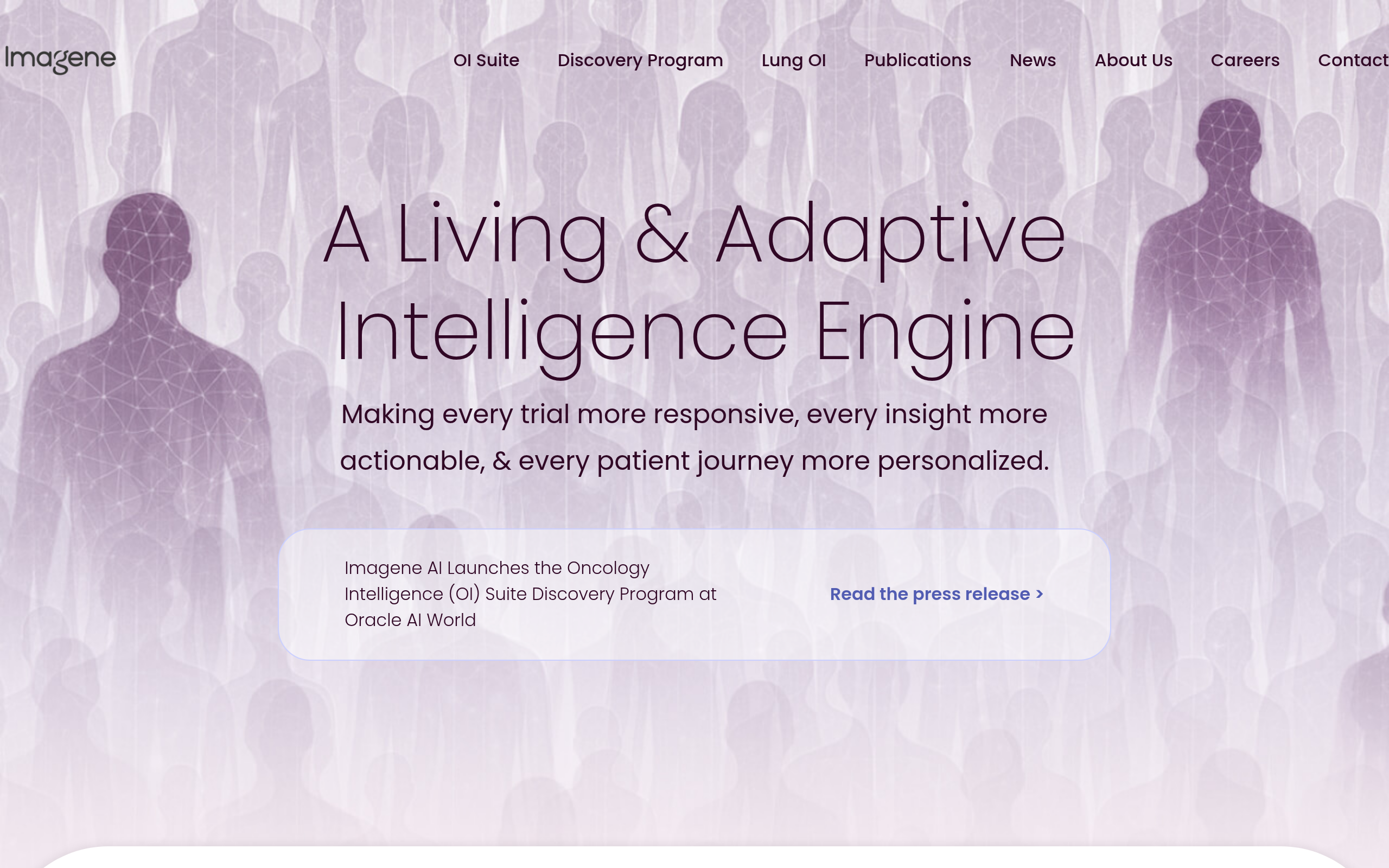
Imagene reads digitized pathology like a molecular test, using computer vision and multimodal AI to infer actionable cancer biomarkers directly from routine biopsy images.
What it powers: Rapid, image‑based biomarker prediction for clinical diagnostics and discovery in precision oncology.
Products and integrations: CLIA‑certified LungOI test with next‑day NSCLC reports via secure LIS; OI Suite for research; integrations with digital pathology stacks (e.g., Sectra) and access via Tempus.
Impact and validation: Peer‑reviewed validations; LungOI secured a specific Medicare payment code; partnerships with Hoag Hospital and Oracle.
Fit and deployment: Suited to cancer centers and biopharma R&D; HIPAA‑compliant CLIA/CAP lab with cloud and on‑prem options.
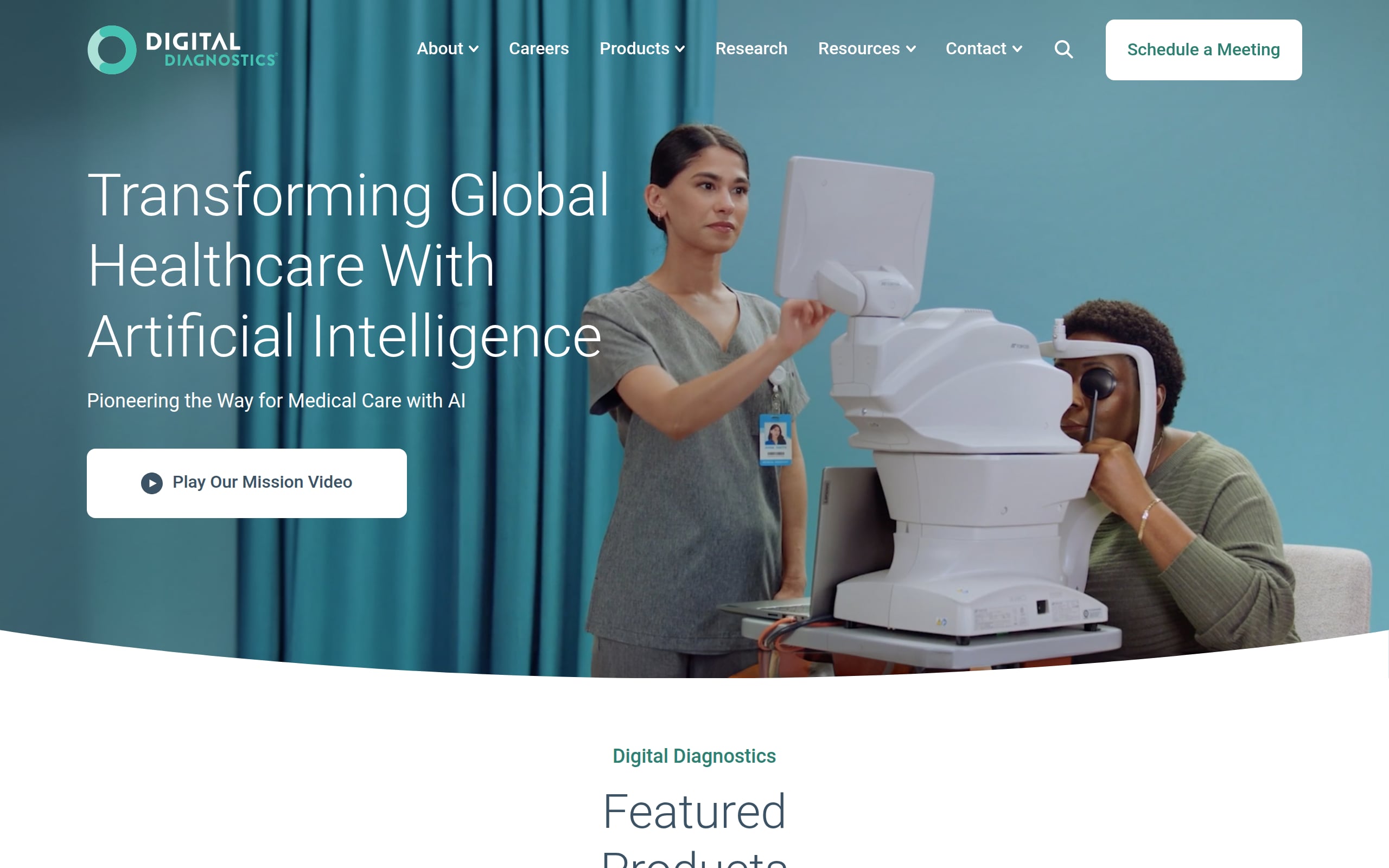
Digital Diagnostics pioneered autonomous AI in medicine, delivering point‑of‑care detection of diabetic retinopathy without clinician over‑read, so primary care can close gaps and bill confidently during the same visit.
What it powers: In‑clinic diabetic eye exams with CPT 92229 reimbursement, enabling HEDIS gap closure.
Products and integrations: LumineticsCore pairs with Topcon cameras and SphereDx, sending reports into EHRs like Epic; proven at OCHIN sites and Labcorp centers.
Impact and validation: First FDA‑authorized autonomous AI (2018) with ~87% sensitivity and ~91% specificity; recognized by NCQA and ADA; OSF HealthCare found disease in 25% of patients screened.
Fit and deployment: For health systems, FQHCs, and primary care groups; HIPAA‑compliant, deployed on‑site.
The financial health of a healthcare organization is intrinsically linked to the efficiency of its administrative processes. The companies featured here are leveraging AI to automate and optimize the revenue cycle, from medical coding and clinical documentation improvement (CDI) to billing and claims processing. By reducing errors and streamlining these complex workflows, these AI solutions help healthcare providers improve their financial performance and ensure they are appropriately reimbursed for the care they deliver.

Nym makes autonomous medical coding auditable and accurate, translating unstructured notes into compliant ICD‑10/CPT with a clinical language understanding engine built on medical ontologies.
What it powers: Direct‑to‑bill coding for ED, radiology, and outpatient encounters with robust audit trails.
Products and integrations: Autonomous Medical Coding Engine slots into billing cycles; standards‑based, FHIR‑first integrations with Epic, Oracle Health, and MEDITECH.
Impact and validation: 6M+ charts annually across 250+ facilities; Inova reports $1.3M savings and 50% DNFB reduction; KLAS Top Performer.
Fit and deployment: For health systems and large specialties; HIPAA compliant, SOC 2, cloud delivery.
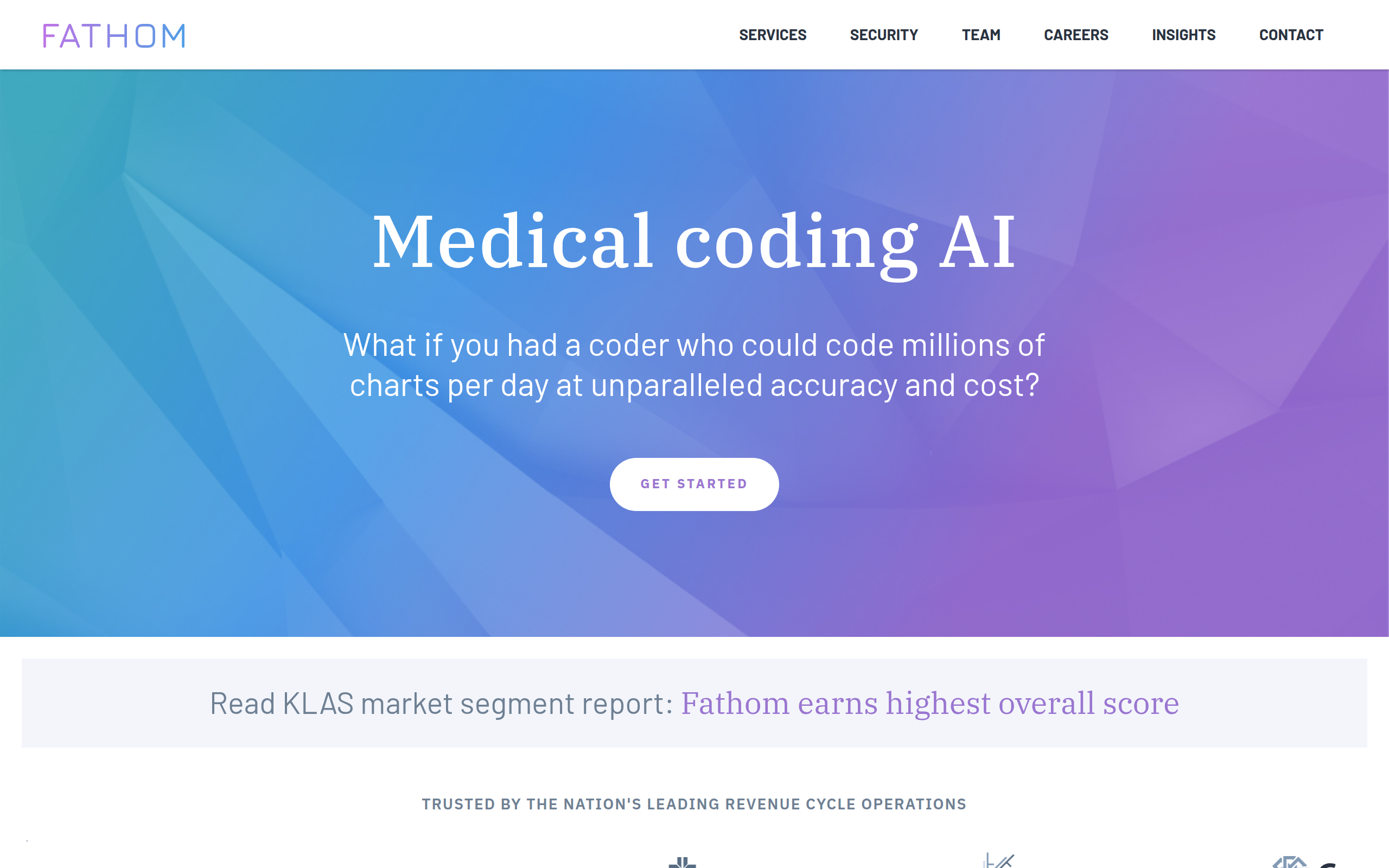
Fathom’s deep‑learning and NLP engine codes encounters autonomously at enterprise scale, clearing backlogs and pushing compliant claims straight to bill.
What it powers: Production coding, backlog remediation, and real‑time audit/QA across ED, radiology, and primary care.
Products and integrations: Coding automation platform with enterprise EHR/PM connectivity, including Epic (Showroom‑listed), Oracle Health, MEDITECH Expanse, MEDHOST, and athenahealth.
Impact and validation: 63M+ encounters at 3,000+ sites; 95.5 KLAS score with 90%+ automation; ApolloMD cites major cost savings and cycle‑time cuts from days to hours.
Fit and deployment: Best for large health systems and RCM firms; HIPAA/SOC 2/HITRUST, cloud.

SmarterDx brings clinical reasoning to revenue integrity, scanning inpatient charts pre‑bill to surface missed diagnoses and generate evidence‑backed appeals and even auto‑draft physician notes with generative AI.
What it powers: Pre‑bill clinical documentation improvement, denials management, and physician note generation.
Products and integrations: SmarterPrebill, SmarterDenials, SmarterNotes; connects with Epic, Oracle Cerner, MEDITECH and runs alongside 3M/Nuance RCM tools, deploying in weeks.
Impact and validation: 60+ health systems, average 5:1 ROI; KLAS notes 100% high satisfaction with immediate outcomes; 2025 MedTech Breakthrough award.
Fit and deployment: Best for large health systems; HIPAA‑compliant, SOC 2, rapid SaaS deployment.
Selecting the right AI partner is a critical strategic decision. As you evaluate different ai healthcare companies, consider the following criteria to find the best fit for your organization.
Generic AI platforms often lack the specific knowledge needed to navigate complex healthcare workflows. Look for companies that are built from the ground up for healthcare. Do they understand payer IVR systems? Are their voice agents trained on medical terminology? A specialized partner like Prosper AI provides pre built “Blueprints” for workflows like benefits verification and prior authorization, which ensures faster deployment and higher accuracy.
To be effective, an AI solution must seamlessly connect with your existing systems. Ask potential vendors about their integration experience with your specific EHR or Practice Management system. The best platforms offer dozens of native integrations with major vendors like Epic, Cerner, and athenahealth, minimizing the IT lift required from your team.
Healthcare organizations can’t afford to wait years for a return on investment. Look for solutions that can be implemented quickly. Some AI healthcare companies can get you live in as little as a few weeks, allowing you to see a tangible impact on call volumes, staff workload, and revenue much faster than traditional software implementations.
The current wave of AI in healthcare is focused on automating burdensome processes and providing decision support. The next frontier is proactive and personalized medicine. AI will help predict which patients are at risk of missing appointments, which claims are likely to be denied, and which treatments will be most effective for an individual’s unique genetic profile. The AI healthcare companies that thrive will be those that can transform data into predictive insights, helping providers move from reactive problem solving to proactive care management.
The landscape of AI healthcare companies is dynamic and expanding rapidly. These innovators are not just creating incremental improvements, they are fundamentally redesigning the administrative and operational infrastructure of healthcare. By automating manual tasks, reducing administrative waste, and freeing up staff to focus on patient care, AI is creating a more efficient, accessible, and sustainable healthcare system. As technology continues to evolve, the impact of these companies will only grow, paving the way for a future where administrative burdens are a relic of the past.
Ready to see how AI can transform your patient access and revenue cycle workflows? Get a personalized demo.
AI healthcare companies develop and implement artificial intelligence solutions to solve problems across the healthcare industry. This includes automating administrative tasks like appointment scheduling and benefits verification, aiding in clinical diagnosis through medical image analysis, accelerating drug discovery, and personalizing patient treatment plans.
AI is used in patient scheduling to automate the process of booking, rescheduling, and canceling appointments. AI voice agents can answer patient calls 24/7 with zero hold time, text patients to fill last minute openings, and send automated reminders to reduce no shows. This frees up front desk staff and improves the patient experience.
Yes, reputable AI healthcare companies that handle patient data must be HIPAA compliant. They employ robust security measures like end to end data encryption, secure data centers, and access controls. Many also obtain third party security certifications like SOC 2 Type II to further demonstrate their commitment to data protection.
RCM (Revenue Cycle Management) automation uses AI to handle manual, repetitive tasks related to billing and collections. This includes verifying patient insurance eligibility, initiating and following up on prior authorizations, checking the status of claims, and helping with denial management. The goal is to reduce costs, speed up payments, and increase net collections.
When choosing a partner, look for a company with deep specialization in healthcare workflows, not a generic AI provider. Ensure they can integrate with your existing EHR and practice management software. Finally, ask about their implementation process and timeline to understand how quickly you can expect to see results.
Discover how healthcare teams are transforming patient access with Prosper.
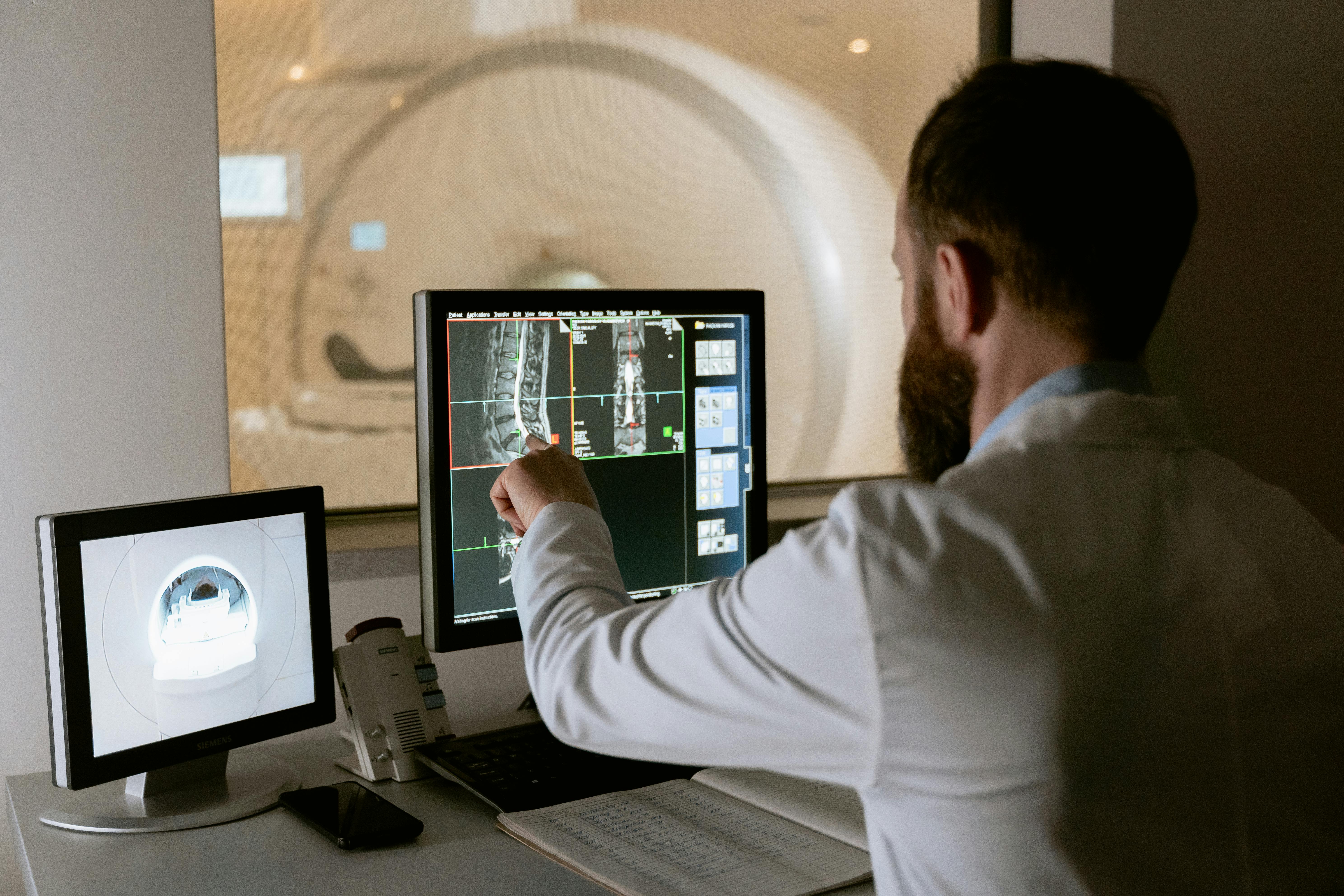
Explore 22 real-world examples of AI in hospitals—from chatbots and no-show prediction to imaging and billing—that boost efficiency and patient care outcomes.

Discover 14 AI use cases for healthcare, from imaging and triage to drug discovery and population health. See real results, ROI, and tools to start fast.

Should AI be used in healthcare? Weigh benefits and risks, address bias, privacy and oversight, and learn practical steps for safe, ethical adoption. Read on.